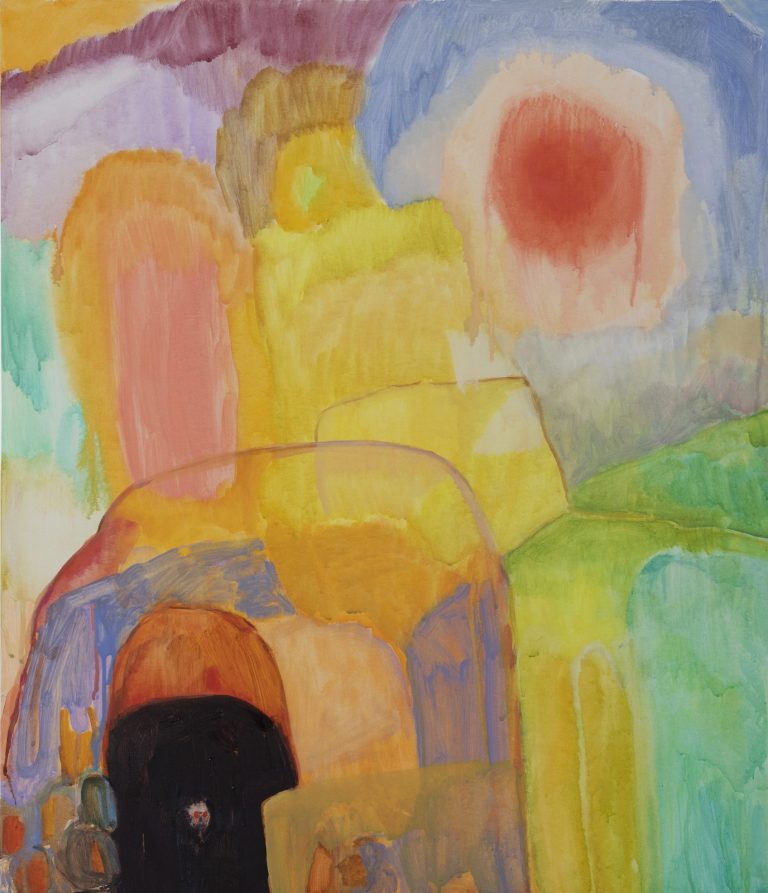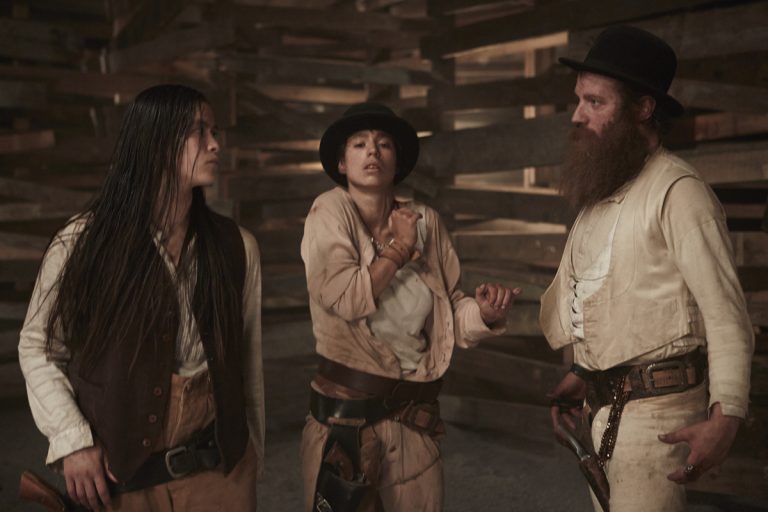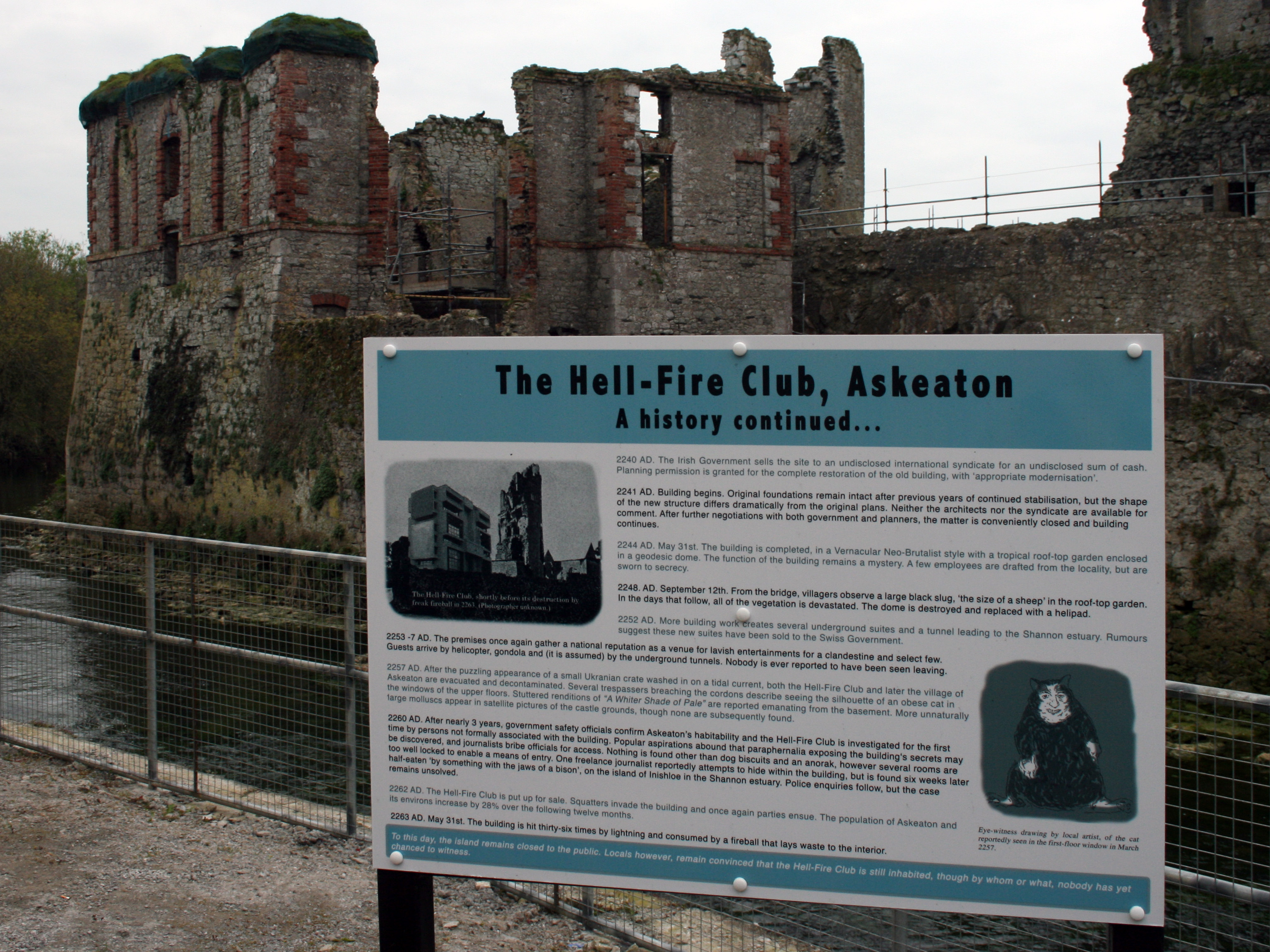The curators of the 7th Berlin Biennale for Contemporary Art have a very clear political manifesto. Entitled Forget Fear: Act for Art, this edition is less about exhibiting art works. Instead, its goal is to address and reflect the social and political unrest in the current global financial crisis.
The Biennale and indeed, contemporary art are used here as a political forum to open up public debate on the various forms of political resistance taking place across the globe. It encompasses a multitude of various specific polemics such as the manipulation of events in current media reportage and the hegemony of religion and western capitalism. The influential power of religion, from the dogmatic teachings of Catholicism to the apparent fanaticism of Islam, is suggested in the work of Miroslaw Patecki’s Christ the King and addressed in the actions of Public Movement’s advertising campaign Rebranding European Muslims.
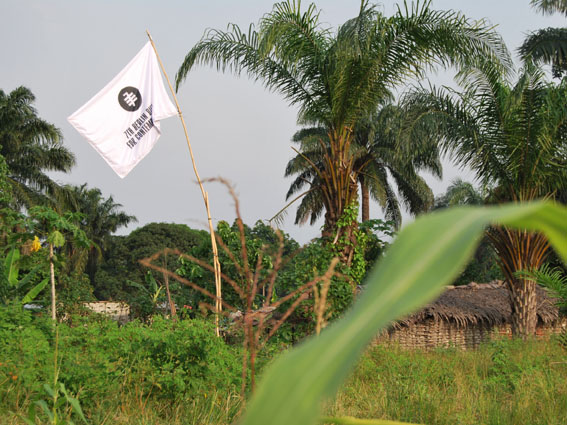
Institute For Human Activities, 7th Berlin Biennale, 2012, Photo: ©The Institute for Human Activities; Courtesy the BB7.
It is the aspiration of curators Artur ?mijewski and Joanna Warsza and associate curators, a Russian art collective called ‘Voina’ (translated as ‘War’), that the transformative power of art will effectively achieve a mass collective self-organisation against the evils of capitalism and corrupt governance. Described in the curators statement as ‘agonistic curating’, the intention is to emphasise the possible positive outcomes of a political conflict through an oppositional stance to the dominant opinion. This strategy is considered as a way of revealing ‘a political truth’ in which the artist’s role in the context of this Biennale is viewed as that of a politician. Here, political activism is presented as art and art as political activism.
Most prominently, the inclusion of ‘Indignados | Occupy Biennale’, activists from the protest movements of Occupy Berlin, Frankfurt and New York in the ground floor hall of the KW Institute situates this as the primary agenda. A rolling programme of participatory events is scheduled daily in the space of the ‘Autonomous University’. These events are independently led, uncurated and unsupervised – exemplifying a performative democracy yet a lack of critical engagement.
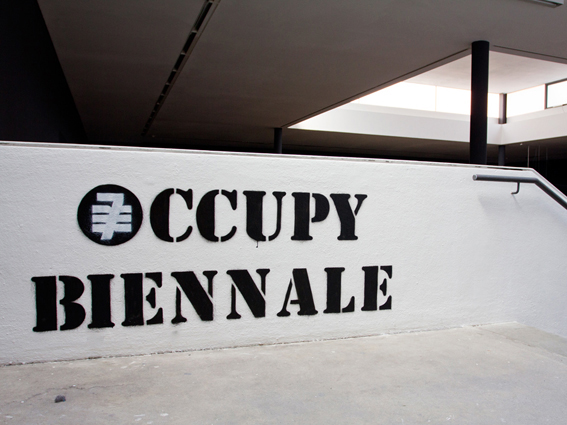
Occupy Biennale, KW Institute of Contemporary Art, 7th Berlin Biennale, 2012, Photo:©Marta Gornicka; Courtesy BB7.
Upon entering the KW Institute, the corridor leading to the main space is covered with graffiti and fly-posted literature – suggesting an aesthetics of resistance. The space itself reveals a pitched tent, tables covered in pamphlets and a round table discussion about to take place. The situating of the Occupy movement in a non-profit publicly funded institution as the KW Institute immediately draws parallels with the recent occupation and eviction of Occupy Wall Street in Zuccotti Park and Occupy London at St. Paul’s Cathedral. Yet, it signifies a new ideological turn by transforming the space of the KW Institute for Contemporary Art into an ‘advocacy space’ for activist movements. It also forms a critique of the role of the art institution as an emblem of power within contemporary art spheres.
Upstairs, on the first floor, the sculptor Patecki is slavishly recreating, out of polystyrene, the head from one of the biggest statues of Jesus Christ in the world. The statue was installed on the outside of the Polish town of ?wiebodzin in 2010 and designed by Patecki himself. Adjacent to this, a film produced by Anna Baranowski and Luise Schroeder entitled Facing the Scene documents the ceremonial installation of the statue in November 2010. It depicts with meticulous detail the display of reverence for the statue demonstrated by the church community – an icon of the Catholic Church’s institutional power.
On the top floor, photographs of the actions of the Institute for Human Activities project are exhibited. The institute’s gentrification project is a five-year programme located eight hundred kilometres upstream from Kinshasa, on the river Congo. Designed to highlight the impact artistic activity has on the gentrification of an area, the intention here is transform this potential into an interventionist tool. The Institute in an open letter extends an invitation to the public to join the programme in June in the Congo, with visa and travel costs reimbursed.

Jonas Staal: “New World Summit”, 7th Berlin Biennale, Photo: ©Marta Gornicka; Courtesy BB7.
Rotterdam-based artist Jonas Staal proposes an alternative parliament for political and juridical representatives of organisations currently placed on international terrorist lists in ‘The New World Summit’. The Summit is suggested to have occurred on 4-5 May 2012. However, no documentation of the actual event and political exchange is presented in the installation. Staal presents a strong argument that ideologically democracy has failed by deliberately excluding certain political parties from participating in national and international politics. The non-transparent terms by which the activities of these organisations are determined as terrorist, is never fully disclosed to the public. In his own words Staal has said that “violence is nothing more than a bad articulation of something that could be said in better terms.”
Within the exhibition space, the flags of each organisation are suspended from the ceiling accompanied with a model of the political agora. Amongst the organisations represented are ‘Saor Eire’ and ‘The Red Hand of Ulster’. Significantly the majority of the insignias of each group include an emblem of violence, such as a closed fist gripping a Kalashnikov machine gun. Whether violent or not, the call to arms appears to be an embedded ideology in the majority of these organisations. With ‘New World Summit’, Staal hopes to create an egalitarian, fundamentally open and democratic society by administering its principles, albeit in a radical form.
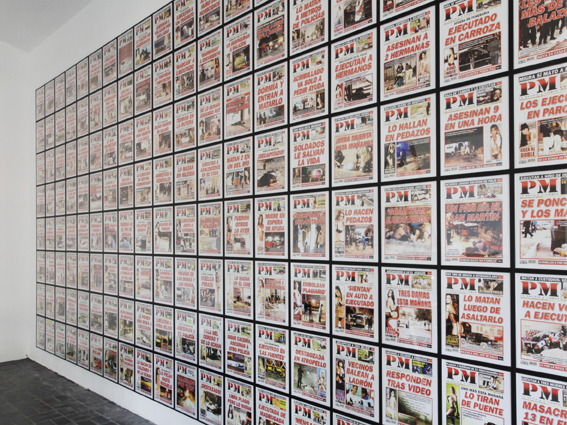
Teresa Margolles: PM 2010, 7th Berlin Biennale, Photo:©Marta Gornicka; Courtesy BB7.
With Teresa Margolles work, Covers of PM, A Local Newspaper of Ciudad Juárez, Mexico from February 2010, the entire back wall of the upper floor of the KW Institute is decorated with the front pages of PM newspaper. Each cover contains graphic images from a crime scene juxtaposed against an image of a scantily clad woman. An accompanying text explains that on February 1, 2010 the story of a massacre in which thirteen students took place was published. This was the single most horrific example of the civil unrest and gang violence that was taking over the country. In 2010, it was recorded that there were 3951 murders in Ciudad Juarez, 476 of these were women. These fatalities are a result of the on-going gangland drug warfare destroying Mexican society.
In response to the Margolles installation, Antanas Mockus, a former mayor of Bogotá and political thinker, sets a proposition to the Biennale public in Blood Ties. Mockus claims that 47 die every day in the drug war in Mexico. Those who donate a drop of blood and choose to sign a legal waiver to abstain from the use of drugs during the course of the Biennale are directly contributing to the reduction of human fatalities in Mexico, as a result of the drug war. A Mexican flag attached to a pulley will slowly be either hoisted or lowered into a pool of liquid if the homicide rate increases or decreases during the course of the Biennale. This action attempts to trace the complicity of the recreational drug user with the drug’s violent origins. Mockus also claims in his statement that if the homicide rate does not drop during the Biennale, he will declare himself ‘a failed artist and art a pretentious concept’. Such a symbolic gesture is admirable but effectively politically impotent.

Antanas Mockus: Cocaine Machine, 7th Berlin Biennale, 2012, Photo:©Antanas Mockus.
Beyond the inclusion of such art-activist movements in Forget Fear, it is difficult to interpret any critical engagement with the artworks and actions exhibited. How the political agency of an artwork is measured in concrete, effective terms remains a contentious issue and this democratic and egalitarian curatorial approach is commendable but inherently problematic. The political gestures of many of the actions exhibited does not visibly extol any significant results and the various, divergent discourses taking place within Forget Fear detract from a collective action and become more of a declaration of one’s own political position. All these issues culminate in a Biennale, which although is well intentioned, lacks any real political impetus. The ambition to shock and provoke the public into a state of protest through such artistic gestures, instead through its execution, encourages the questioning of the artist’s commitment to their political cause. It seems in the current global climate of social unrest, what is most urgently needed is not gestures but actions.
Ruth Hogan is a writer and curator based in London.
.

